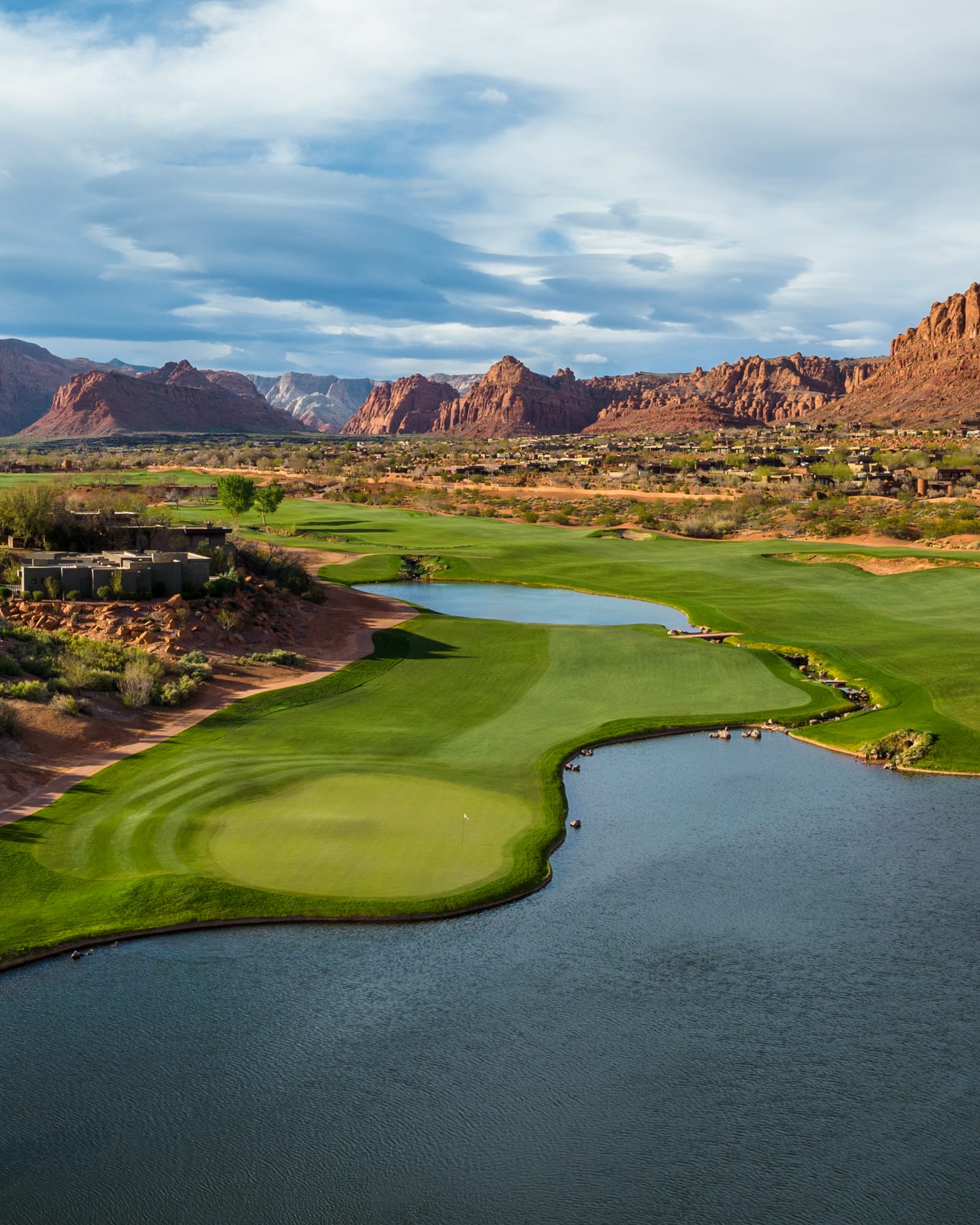Dishing Out Awards for Best Renovations, Restorations and New Golf Courses From 2022

Although the pandemic prompted a significant boost in play, paving the way for a multitude of golf course improvement projects, new course openings in 2022 were nowhere as voluminous as they were two decades ago. But a lack of quantity does not mean a lack of quality. Familiar names such as Coore-Crenshaw, Gil Hanse and David McLay Kidd were among those who scored hits in 2022. Plenty of other brand-name designers emerged with superb layouts as well.
Admittedly, we’re salivating at the prospects that await in 2023, when Tom Doak’s Lido officially opens at Wisconsin’s Sand Valley, along with the two extreme makeovers at Florida’s World Woods, 46 holes at Texas’ new PGA Frisco and multiple debuts from Bill Coore and Ben Crenshaw, including Cabot’s Point Hardy on St. Lucia. Expect those courses to earn their share of medals, ribbons and critical praise—next year. For this year, we solicited feedback from architects, PGA professionals, superintendents and other industry insiders to arrive at the most notable courses to open in the past 12 months. Here are the Top 10 new and newly renovated courses of 2022.
Best New Public Course: Landmand Golf Club, Homer, Neb.
In 2017, the names Tad King and Rob Collins burst into the brains of course connoisseurs everywhere. In August of that year, word began to spread about what their King-Collins firm had accomplished with a redesigned nine-hole layout in rural Tennessee called Sweetens Cove. Eager to prove they were no one-hit wonder, King-Collins opened its first 18-hole creation in September, Landmand Golf Club in Nebraska. Mission accomplished. Landmand is already so acclaimed for being so distinctive, King and Collins are guaranteed to lose their anonymity forever.
Located on fourth-generation farmland in the northeast corner of the Cornhusker State, roughly 10 miles south of Sioux City, Iowa, Landmand (the closing "d" is silent) is named after the Danish word for farmer, reflecting the Andersen family’s (the farm owners) heritage. The Danish word for “massive” would be helpful to know as well, because Landmand occupies an almost incomprehensibly vast arena, 580 acres, three times the size of an average course.
The 7,200-yard, par-73 layout sprawls with abundantly roomy fairways up to 100 yards in width that provide multiple routes to the hole, and features a set of greens that are as enormous—yet varied—as any collection of putting surfaces in the game. Most notable is the 30,000-square-foot dance floor at the 315-yard, par-4 17th, where one could drive the green—and still make double-bogey. Walkable, though with moderate elevation change, Landmand is pure fun, especially for the drive-for-show, putt-for-dough crowd.
Best Public Course-Silver Medal: RainDance National Resort & Golf, Windsor, Colo.
If you had guessed that perennially short but straight hitter Fred Funk would have a hand in designing America’s longest golf course—congrats! You’ve got a stupendous crystal ball.
Situated 55 miles north of Denver and 20 miles southeast of Fort Collins, RainDance is a design collaboration between Funk and Harrison Minchew, who spent 26 years as an in-house architect with Arnold Palmer’s design firm. Set in the high desert at nearly 5,000 feet elevation, the thin air at RainDance helps account for the back tee length of 7,845 yards, though it can actually top out at 8,485 yards, an ideal test of strength for Arnie in his prime, or for today’s collegiate stars. The terrain features 20- to 30-foot-deep arroyos that flow down to the Cache la Poudre River, along with 250 feet of elevation change. “I’ve never had such a beautiful golf-only site with ideal terrain like RainDance,” said Minchew, who has seen his share.
Best Public Course-Bronze Medal: Bar Run Golf & RV Resort, Roseburg, Ore.
Following the successful rollout of its first 10 holes in 2021, Bar Run debuted its full 18 in July to equal acclaim. Located in the southwestern portion of the state—not on the coast, but on the way to Bandon—the 6,215-yard, par-70 spread features a design from Dan Hixson, who also crafted Washington’s Wine Valley and Oregon’s Silvies Valley Ranch. Hewn from a sand and gravel mine along the South Umpqua River, Bar Run delivers three holes that skirt the river, Nos. 8, 10 and 11, and other holes that feature machinery from the still-active mining operation. Its odd sequencing sports four par 3s on the back nine and only two par 4s, Number 17 and 18. If you favor fun, whimsy and affordability (green fees under $100), sprint to Bar Run.
Best New Private Course: Ladera Golf Club, Thermal, Calif.
Entertainment mogul Irving Azoff understands movies and music. His good friend, Apple executive Eddy Cue, understands Big Tech. Building a golf club from scratch? Not so much. Both are passionate golfers, however, who recognized that world-class golf courses in the California desert were lacking. They dreamed of creating something different and unique, a very special, private, traditional golf club in the Coachella Valley. So, they summoned top industry consultant GPI (Golf Projects International) to build the ultimate development team, to manage the project and help them realize their vision. Architect Gil Hanse and his design partner Jim Wagner signed on to handle the design, and the rest is history—except that there’s almost no recorded history about Ladera.
Perhaps the most exclusive, mysterious American golf course project since Steve Wynn and Tom Fazio created Shadow Creek in 1989, Ladera flies so far under the radar that even with a search engine, it’s hard to find any references. Yet, several insiders who educated us about Ladera’s merits were so enthusiastic in their reviews, it’s an easy choice as Best New Private Course in the world.

Ladera Golf Club, Thermal, California

Ladera Golf Club, Thermal, California

Ladera Golf Club, Thermal, California

Ladera Golf Club, Thermal, California
Understandably, Hanse himself is one of those boosters. During construction, he described how the tranquil site featured significant elevation change and outstanding mountain views. With the landforms created, amazing shadows would be the norm.
“Our clients have given us significant resources, a 300-acre blank canvas and no other requirements except for those surrounding golf,” Hanse told me in April. “Jim (Wagner) and I have worked hard to create a ‘believable’ landscape on this property. By that, we mean, the topography, the creation of dry washes that run through the property, the landscaping of the golf and the areas between holes, all are done in a fashion that would be plausible if you found a terrific natural site at the foot of the mountains in the desert.
“We have also created landforms throughout the property that extend from one hole to the next. This gives the site a natural flow and goes against what ‘big earth’ jobs would attempt to do, which is to put golf holes in their own cocoons.”
One feature that weaves its way through many of the holes is a sand-filled barranca that at times measures 100 yards wide, which adds both strategic and aesthetic pleasure to the round. GPI recruited the Pinnacle Company design team to develop a landscape plan for the site. They used native materials extensively and landscaped the barranca, and the transition to the desert with rock gardens, native plant material and sycamore trees, lending further character and appeal. Hanse and Wagner also restored a lemon grove to part of the property, reflecting Ladera’s long heritage as a citrus ranch. Mango trees also populate the site, which retains a full 50 acres of citrus trees.
Yet, Ladera’s emphasis on eye candy is secondary. First and foremost, Ladera is designed to appeal to traditionalists. It is the rare Palm Springs area desert course that is intended to be walked—and it is indeed walkable. Although vast in scale, with large greens that vary tremendously in shape and undulation, the course plays firm and fast. To ensure these conditions continue in high season (October-May), Ladera will eschew overseeding—quite possibly a singular trait among elite desert courses. The straw-colored hue of the Bermudagrass may not appeal to real estate buyers, but that’s of no concern to Azoff and Cue, as surrounding homes are not in the masterplan.
What is of concern to Azoff and Cue, and their golfing sons, is that Ladera appeal to traditionalists, players who take the values and virtues of golf seriously. Dormant Bermuda provides a firm, superb surface to play from, regardless of appearance. Thoughtful shot-making demands appear throughout the layout, starting at the first hole, a downhill par 5 of about 550 yards. A la Riviera, the tee box is mere steps away from where the clubhouse will go, and next to the practice putting green. Golfers are asked to make decisions immediately, in terms of positioning both the drive and the second shot, thanks to the barranca that bisects the fairway.
Located 40 minutes southeast of Palm Springs, and just 12 miles from the golf mecca of La Quinta, Ladera is unique. Its mysteriousness has been compounded by news reports over the past 12 months that had the club identified by different names, including Coachella Golf Club, Lemon Blossom and Jeule Ranch. Its exclusivity will guarantee that its mystique will only grow. In fact, Ladera is so low-key, that while all 18 holes, the practice facilities and the 9-hole short course are finished and are currently being enjoyed, there are no members as yet. In time, when Azoff and Cue decree it, there may be members, whether 50 or 150, but it’s also possible that there will never be an official opening date—or any members. As private playgrounds go, Ladera is world-class—and in a class by itself.
Best New Private Course-Silver Medal: Lost Rail Golf Club, Gretna, Neb.
Another standout in the ever-growing roster of terrific tracks in Nebraska, Lost Rail didn’t garner many reviews from our insiders, but those who responded were universal in their acclaim. Opened in early September, Lost Rail features the handiwork of architect Scott Hoffman, who formerly worked for Tom Fazio and for a Fazio spin-off, Jackson-Kahn. Located a half-hour west of downtown Omaha, this was a special project for Hoffman, an Omaha native. To create the first private club in the Omaha area in 25 years, Hoffman enlisted the assistance of another Cornhusker, Bill Kubly, CEO of ace course builder Landscapes Unlimited. Together, they’ve done their state proud.
What resulted is a 7,309-yard, par-71 layout that features ridges and valleys, amid rolling pastureland, some of which is tree-covered, some of which is open farmland. Reviewers all praised the walkability, the wide, firm, fescue-framed fairways and the variety of holes, especially the green complexes. What resonated strongest, however, are the front nine holes that give the course its name. Those holes, starting with the downhill, 188-yard par-3 5th, embrace remnants of the Burlington Northern Railroad line that once connected Omaha to Sioux City. Though mostly disassembled in 1926, one vestige remained, a 10-foot-high railbed that crosses roughly 500 yards of Lost Rail property. “At one point, the bed collapsed over the ravine and formed a 40-foot canyon,” Hoffman said. “There’s nothing in golf quite like it. You’d swear the earth swallowed a boxcar!”
Best Golden Age East Coast Private Course Renovation: Belleair Country Club (West), Belleair, Fla.
Led by architect Jason Straka of Fry/Straka Global Golf Course Design, Belleair Country Club near Clearwater undertook a comprehensive restoration project of its historic Donald Ross-designed West course—one he designed in 1915 and redesigned in 1924. It succeeded brilliantly. Florida’s first golf club was originally a six-hole design dating to 1897 and alternated through the years between the names Bellview and Belleair. After parting ways with the old Belleview Biltmore hotel, it became a members-only club called Belleair in 1987.
Unusual for the west coast of Florida, Ross’s old No. 1 course boasted 30 feet of elevation change and was set beside half a mile of frontage on Clearwater Bay. Straka had access to all of Ross’s construction plans from both the 1915 and 1924 versions and used them to create a set of modern construction drawings. That allowed Straka and Clarke Construction Group to bring back Ross’s original features, including old style cop bunkers. It also permitted them to reconstruct Ross’ greens, which were nothing like the “inverted-saucer style” many attribute to Ross. In fact, Belleair’s greens had evolved into that concept only through years of rebuilds and topdressing. Long-hidden ravines and streams are back in play, bay views abound, fairway width has been restored and the superb Ross greens are placed where he intended them to be, almost all of them at the existing grade, not propped up. Bravo, Belleair!
Best Golden Age West Coast Private Course Renovation: Lake Merced Golf Club, Daly City, Calif.
When you’re situated in the same neighborhood as the Olympic Club, TPC Harding Park and San Francisco Golf Club, sometimes it’s tough to get noticed. Lake Merced Golf Club has definitely tried over the years, hosting USGA and LPGA Tour events in recent years, with Lydia Ko a three-time winner. What has prompted atomic-level buzz, however, is this autumn’s reopening of its 100-year-old layout, by Gil Hanse and Jim Wagner. In a “restovation” comparable in some ways to Kyle Phillips’ success at the California Golf Club of San Francisco a few miles away, Hanse and Wagner restored many concepts and design features installed in 1929 by Alister MacKenzie and in other cases, created new holes that captured the MacKenzie “vibe” (as Wagner put it) when the old holes couldn’t be replicated. Feedback so far is that Lake Merced has succeeded with an eye-popping triumph.
“The job was a total blow-up,” Wagner said, though he was quick to qualify. “The club wanted a restoration and we did have great photography from the 1930s. At 1, 4, 5, 10 and 13, for example, we were able to put the holes back as MacKenzie created them. But we couldn’t do that everywhere. The property had undergone too much radical change through the years.”
The restored par-3 13th encapsulates the beauty of the site and MacKenzie’s artistry, with gorgeously sculpted bunkers and handsome cypress trees. Two of the new holes on the re-routed course, the par-4 10th and the par-3 16th, almost eerily embrace the MacKenzie style. Hanse and Wagner are no strangers to restoration accolades. With Lake Merced, they’ve raised the bar even higher.
Best Modern Private Course Renovation: Atlanta Athletic Club (Riverside), Johns Creek, Ga.
Architect Tripp Davis, Principal and Lead Golf Architect in Tripp Davis and Associates, had a tricky assignment when he earned the commission to renovate the Riverside Course at the fabled Atlanta Athletic Club. Riverside was the less famous layout at Bobby Jones’s home club. Though it had played host to the 1990 U.S. Women’s Open, won by Betsy King, it usually yielded to its brawnier sibling, the Highlands for big events, such as the 1976 U.S. Open and the 1981, 2001 and 2011 PGA Championships.
Riverside was originally crafted by Robert Trent Jones Sr. in the mid-1960s. Jones’s son Rees effected a successful redesign in 2003, earning Top-10 honors, but two decades later, the club turned to Davis to pursue a slightly, not vastly different direction.

The 2nd hole at Atlanta Athletic Club's Riverside course.

The 3rd hole at Atlanta Athletic Club's Riverside course.

The 4th hole at Atlanta Athletic Club's Riverside course.

The 13th hole at Atlanta Athletic Club's Riverside course.

The 14th hole at Atlanta Athletic Club's Riverside course.

The 16th hole at Atlanta Athletic Club's Riverside course.
Davis knew his marching orders: It would be part renovation of the older infrastructure (irrigation, grasses, subsurface drainage) and part redesign, notably on the stretches of holes 3 through 5 and 12 through 14 that would bring the Chattahoochie River more into play. The three principal goals then were to heighten playing conditions, accentuate the terrain in a more natural way and enhance the playing interest for members and elite players alike. Davis rebuilt and relocated tees, bunkers and greens, removed the dated mounds, yanked out trees to yield handsome river views and injected a Golden Age feel along with enticing risk/reward options. Re-opened in late October, it proved a huge hit with the membership.
Davis’ personal favorite is the new 13th, a par 4 of 417 yards. It’s easy to see why. The green and its three bunkers are angled from front-left to back-right, so the tee shot should ideally find the left side of the fairway. Attempting to gain that position, however, brings a bunker and a mature pine into play. The safer drive to the right leaves a longer shot and a tougher angle. It’s perfect pay-me-now-or-pay-me-later risk-reward. And a wicked slice off the tee could drown in the Chattahoochie.
Working with club superintendent Lukus Harvey, Davis proclaimed the renovation task “a dream come true,” with Davis being an Atlanta native. He was also was a superb amateur player at the University of Oklahoma and he hugely admired Bobby Jones. The tricky part of the assignment? Davis may well have succeeded at making Riverside a more compelling layout than its more celebrated brother. We’ll leave that debate for now. What is certain is that it’s our winner for Best Renovation of a modern (post-World War II) private course.
Best Modern Private Course Renovation (with an asterisk): Entrada at Snow Canyon Country Club, St. George, Utah
When Entrada opened in 1996, the course was undeniably distinctive, but indisputably difficult. Talk inevitably revolved around holes 15, 16 and 17, known as the “lava triangle.” This trio of demanding holes twisted through black lava fields that resembled terrain on the Big Island of Hawaii. Enter David McLay Kidd.
The design mind behind Bandon Dunes, Gamble Sands and Sand Valley, Kidd specializes in courses that entertain with fun options. Called in to overhaul Entrada’s aging irrigation system, Kidd went a giant step further. “We took a good look at the course and could see the massive potential that had gone unrealized for whatever reasons,” said Kidd. “We didn’t want to offend the membership, but when we met with them, we learned that members loved the community, but didn’t enjoy the golf course as much as they should.

The 2nd green at Entrada at Snow Canyon

The 9th hole at Entrada at Snow Canyon

The 16th hole at Entrada at Snow Canyon
“The golf course was way too difficult. Players would routinely lose a half-dozen balls per round from tee shots and most greens were elevated, with catch basins all around them, plus two inches of rye grass rough.”
While keeping the routing mostly intact, Kidd and his team crafted wider fairway corridors, removed some bunkers, grassed over others and pushed the greens down to the grade of the surroundings. When the course reopened in April, players who misfired on their approaches now had options, whether to flop, chip, putt or bump-and-run.
“It’s definitely a desert course,” said Kidd. “You’re out here in Southern Utah, but I wanted to have that links experience. From the design, to the way the grasses are maintained, it’s all about being able to run the ball along the ground and use it to your advantage.”
The “lava triangle” still sparks impassioned chatter, but Kidd made it much more fun to navigate. With his imaginative use of player-friendly contours and slopes, to the arroyo-slashed terrain and the panoramas of sandstone cliffs, Entrada is vastly improved. Outside play at Entrada is limited, as it is essentially a purely private club amid an upscale residential community. However, guests at the 57-room Inn at Entrada have some tee time access.
Best New International Course: Te Arai Links (South), New Zealand
Bill Coore and Ben Crenshaw have done it again. What they’ve done is created a golf course worth traveling a full day for in order to play it. Te Arai Links’ South course, crafted by Coore-Crenshaw, quietly opened in October. Its Tom Doak-designed sibling, the North, is slated to open late in 2023. Located 90 minutes north of Auckland’s Central Business District on New Zealand’s North Island, Te Arai is the sister property to nearby, ultra-exclusive Tara Iti, with its seven-year-old, world Top-20 course, also by Doak. Both destinations were developed by American Ric Kayne and managed by Jim Rohrstaff. The difference between the two properties—and it is a big difference—is that Te Arai is accessible to outside play.
Te Arai looks and plays like a classic links. It’s set along the sea, it plays atop crispy fescue turf with a sandy base, it sports wide fairways and expansive greens, complete with ripples and asks for ground game prowess amid the coastal breezes. Between the architects’ artistry and the wind-shaped sandscapes, it’s nearly impossible to discern between nature and the hand of man. Yes—this is an authentic links.
Holes early and late tangle with tall dunes; in between are lower-lying beachside tests that are individual joys for devotees of Old World shotmaking. Even the holes on the inland side of the formidable dune ridge that crosses the property will conjure up visions of a true Scottish golf experience. Clever contouring, rather than a profusion of formal bunkers, contributes to the challenge. Never is that challenge overwhelming, however, on this 6,779-yard, par-72 spread that’s designed to be walked. Of course, after 14 hours in an airplane to get here, you might be ready to stretch the legs.
Most Innovative Course Design: Stillwater Golf and Country Club, St. Johns, Fla.
Kudos to veteran architect Bobby Weed. Long associated with Pete Dye and the imaginative work Dye did at TPC Sawgrass, Weed reached into his own bag of tricks to succeed at Stillwater. The first new course to open in North Florida in 20 years, Stillwater boasts an 18-hole routing of 6,745 yards, plenty sufficient for the 55 and over active adult community, but conveniently, the layout can be tackled in loops of three, six, nine and 12 holes that start and finish near the clubhouse.
Weed, also a certified superintendent, utilized a number of environmentally friendly measures as well. Planting just 70 acres of irrigated turf helped reduce water use; single cut mowing and an absence of traditional rough reduces maintenance costs and 18 acres of shell screenings in lieu of paved cart paths save further funds and deliver visual contrast.
Additionally Weed installed artificial sod wall EcoBunkers, unique to North Florida, which lend a Scottish ambiance to the proceedings, along with being a cost-saver. Finally, he borrowed from his mentor’s work at Hilton Head’s Long Cove Club in fashioning lay-down walls—planks of treated timber that are seamlessly tied together—to buttress water hazards, as opposed to employing traditional vertical bulkheads. For building a fun, environmentally sensitive layout with ground game emphasis that can be played in three-hole increments, we tip our cap to area resident Bobby Weed and Stillwater.
Best Reimagined Course: Union League National Golf Club, Swainton, N. J.
When it comes to reinvention, Union League National is the Thomas Edison of golf courses. New Jersey native Edison, the prolific inventor who moved to the Garden State in his early 20s, also dabbled at golf, but even he couldn’t contemplate the transformation that has taken place at the golf course once known as Sand Barrens.
Originally designed in 1997 by Dr. Michael Hurdzan and Dana Fry, Sand Barrens eventually ran into financial turmoil, resulting in a sale to the venerable Union League of Philadelphia, a downtown institution since 1862. Understanding that they had purchased a jewel badly in need of repolishing, the new owner retained Dana Fry, now in partnership with Jason Straka to reimagine the 27-hole layout. That’s precisely what has taken place. Inspired by the world’s greatest course, Pine Valley, located just an hour away to the northwest and by Fry’s own work at Florida’s Calusa Pines, he set upon re-sculpting every part of the property.
Critical to what essentially became a brand-new build was the creation of an enormous landform in the center of the property called “The Big Fill,” which completely changed the character of the formerly flat layout. Extending from the towering fill are tentacle-like ridgelines that veer off in different directions that form the basis for holes and features along the tapered terrain.
“All these ridges are like arteries in a human body,” said Fry. “By the time we finished with the major earthwork, the largest section of The Big Fill accommodated eight tee complexes, nine green complexes and parts of seven fairways. It’s that massive, 78 feet high in places. It covers 45 acres. In the same way an architect blends surrounding contours into a single green complex, we are blending an entire routing into the contours we created via The Big Fill.”
The project commenced in 2018, with nine holes at a time being taken out of play so as to always have 18 available holes for members. This past July, Fry and Straka concluded work on the final four holes of the 27 from a design standpoint. Still in progress is a continued repopulating of native grasses, ground covers, shrubs, wetland plantings and trees. Expected completion date for the enhanced vegetation project is 2024. Even Thomas Edison would beam with pride at the creativity on display at Union League National.
Best Short Course: Omni Amelia Island Resort’s Little Sandy, Amelia Island, Fla.
Few architects can touch Beau Welling for his track record of crafting compelling, family-friendly short courses. Evidence of that comes in the form of layouts he’s designed under the Tiger Woods umbrella, such as Bluejack National’s Playgrounds in Texas, Diamante’s Oasis in Cabo San Lucas, Mexico and The Hay in Pebble Beach, California. The April 2022 opening of Little Sandy at the Omni Amelia Island Resort in northeast Florida will further burnish his reputation. Open to resort guests and members of The Amelia Island Club, Little Sandy rolls out 10 holes ranging in length from 70 to 125 yards, each sporting a boldly contoured green. Centrally located within the resort and edging Red Maple Lake, Little Sandy features lake-lined holes, sandy native grass areas, dunes and wildlife habitats. The walking-only layout is intended to be played quickly, and by all ages and skill levels. “We have created a course where players could use just their putters on nearly every hole or use several clubs in their bag, if desired.” said Welling. “The relaxed atmosphere and golf course strategy that includes multiple routes from tee to green will make Little Sandy a haven for fun and creativity.”
